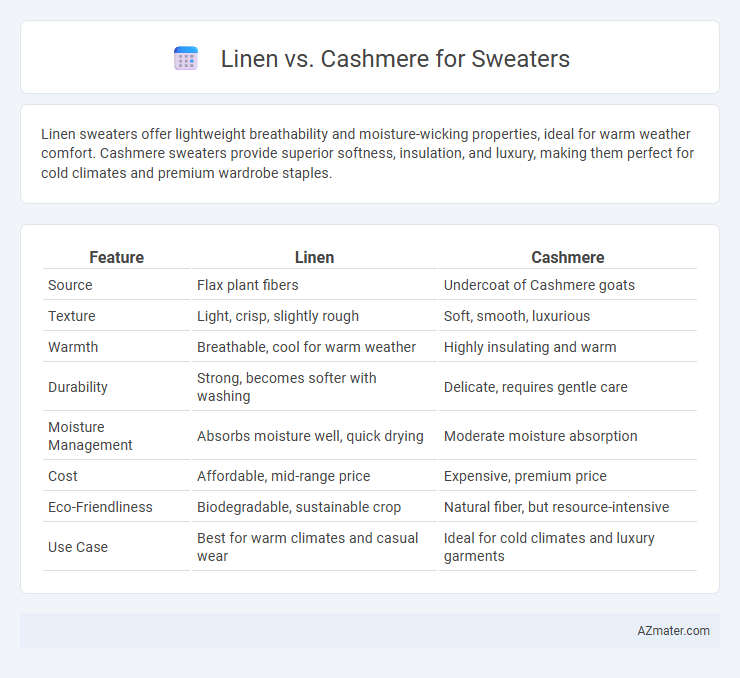Linen sweaters offer lightweight breathability and moisture-wicking properties, ideal for warm weather comfort. Cashmere sweaters provide superior softness, insulation, and luxury, making them perfect for cold climates and premium wardrobe staples.
Table of Comparison
| Feature | Linen | Cashmere |
|---|---|---|
| Source | Flax plant fibers | Undercoat of Cashmere goats |
| Texture | Light, crisp, slightly rough | Soft, smooth, luxurious |
| Warmth | Breathable, cool for warm weather | Highly insulating and warm |
| Durability | Strong, becomes softer with washing | Delicate, requires gentle care |
| Moisture Management | Absorbs moisture well, quick drying | Moderate moisture absorption |
| Cost | Affordable, mid-range price | Expensive, premium price |
| Eco-Friendliness | Biodegradable, sustainable crop | Natural fiber, but resource-intensive |
| Use Case | Best for warm climates and casual wear | Ideal for cold climates and luxury garments |
Introduction to Linen and Cashmere Sweaters
Linen sweaters offer breathability and natural moisture-wicking properties, making them ideal for warmer climates and casual wear. Cashmere sweaters provide exceptional softness, warmth, and luxury, crafted from the fine undercoat fibers of cashmere goats. Both materials present unique benefits, with linen excelling in lightweight durability and cashmere favored for plush comfort and insulation.
Key Differences Between Linen and Cashmere
Linen sweaters are made from flax fibers, offering lightweight breathability and natural moisture-wicking properties ideal for warm climates, while cashmere sweaters, derived from the undercoat of cashmere goats, provide exceptional softness, warmth, and insulation suitable for cold weather. Linen fibers are durable, hypoallergenic, and have a textured, slightly rough feel that softens with use, whereas cashmere boasts a luxurious, smooth texture with excellent thermal regulation and a high price point. Care requirements differ as linen sweaters are generally machine washable and quick-drying, while cashmere requires gentle hand washing or dry cleaning to maintain fiber integrity and softness.
Comfort and Feel: Linen vs Cashmere
Cashmere offers unparalleled softness and warmth, making it ideal for cozy sweaters with a luxurious feel against the skin. Linen provides a lightweight, breathable texture that feels cool and crisp, perfect for warmer climates or layering. While cashmere excels in insulation and smoothness, linen stands out for its moisture-wicking properties and natural texture.
Warmth and Insulation Properties
Linen offers lightweight breathability ideal for warm weather but lacks significant insulation, making it less effective in retaining body heat compared to cashmere. Cashmere fibers provide superior warmth and excellent insulation by trapping air close to the body, creating an efficient thermal barrier ideal for colder climates. For cold-weather sweaters, cashmere's natural insulating properties outperform linen's moisture-wicking and cooling benefits.
Durability and Longevity Comparison
Linen sweaters offer exceptional durability due to their strong natural fibers that resist wear and tear, making them ideal for warm-weather use and regular washing. Cashmere sweaters, while luxuriously soft, require careful handling to maintain their delicate fibers, with less resilience to abrasion and frequent laundering. Over time, linen maintains its structure and appearance better, whereas cashmere demands more maintenance to preserve its longevity and softness.
Breathability and Moisture Management
Linen sweaters offer superior breathability due to the natural fiber's ability to allow air circulation, making them ideal for warmer climates and active wearers. Cashmere, while luxuriously soft, retains heat and has moderate moisture-wicking properties, which can result in less effective moisture management compared to linen. For optimal comfort in humid or hot conditions, linen outperforms cashmere by keeping skin cooler and drier through enhanced airflow and moisture evaporation.
Style and Appearance: Linen vs Cashmere Sweaters
Linen sweaters offer a lightweight, breathable texture with a natural matte finish, often showcasing a slightly rustic and casual style ideal for warm-weather layering. Cashmere sweaters provide a soft, luxurious appearance with a smooth, tightly knit fabric that exudes elegance and sophistication, perfect for formal or polished looks. The crisp, airy aesthetic of linen contrasts with the plush, cozy drape of cashmere, making each material distinct in style and visual appeal.
Care and Maintenance Requirements
Linen sweaters require gentle hand washing or machine washing on a delicate cycle with cold water to prevent shrinkage and maintain fabric breathability, while avoiding bleach and excessive heat during drying. Cashmere sweaters demand even more careful maintenance, including hand washing with a mild detergent or dry cleaning, as the fibers are prone to pilling and matting, and should be dried flat away from direct sunlight to retain softness. Regularly using a cashmere comb or fabric shaver helps remove pills, ensuring longevity and maintaining the luxurious texture of cashmere garments.
Environmental Impact and Sustainability
Linen sweaters, made from flax fibers, have a significantly lower environmental impact due to flax's minimal water and pesticide requirements, making linen highly sustainable and biodegradable. Cashmere production, often associated with overgrazing by goats, can contribute to land degradation and biodiversity loss, raising concerns about its long-term sustainability despite its luxurious texture. Choosing linen over cashmere supports eco-friendly fashion by reducing resource consumption and promoting regenerative agricultural practices.
Choosing the Right Sweater: Linen or Cashmere?
Choosing the right sweater depends on your priorities: linen offers breathability, moisture-wicking properties, and lightweight comfort ideal for warmer climates or layering in mild weather, while cashmere provides superior softness, insulation, and luxury warmth suited for colder temperatures. Linen sweaters are durable and hypoallergenic, making them perfect for sensitive skin and casual wear, whereas cashmere sweaters require delicate care but deliver unmatched plush texture and elegance. Consider climate, maintenance, and intended use when deciding between linen's airy, natural fiber and cashmere's cozy, premium feel.

Infographic: Linen vs Cashmere for Sweater
 azmater.com
azmater.com